With more than 2.3 million visits each year, Sharp HealthCare sees plenty of patients pass through its doors. That means ensuring patient information is easily accessible within its electronic health record system – and that patients are correctly identified – is critically important.
Sharp's work to ensure the integrity of its digital records is highlighted in a new case study published by the College of Healthcare Information Management Executives.
The implementation of new IT systems across integrated delivery networks can mean big challenges in linking to one another within an organization, say CHIME officials. Beyond that, pressures of healthcare reform are prompting organizations to form relationships with other providers – in ambulatory or post-acute care settings – that typically run different information systems and have less IT prowess.
Against that backdrop, provider organizations that were once competitors are now trying to put aside differences to work on large-scale healthcare information exchange projects.
Sharp's situation is one that is typical to providers nationwide, says Bill Spooner, senior vice president and CIO at Sharp.
"In an era of frequent mergers, innovative provider affiliations, collaborative care arrangements and declining revenues, it is essential to view our patients across that entire care continuum," Spooner said in a press statement.
But despite the technical challenges posed by that integration, the benefits are clear, he says: "Robust interoperability is a competitive advantage deserving greater appreciation."
Sharp's seven hospitals use one EHR system (Cerner), while docs at its medical groups use another (Allscripts). Sharp then uses a separate application to create a virtual patient record in which data is brought together and aggregated from a variety of sources.
Data is mapped from the hospital and medical group applications using a labor-intensive process that requires review by IT staff with clinical backgrounds, according to Elizabeth Renfree, director of interoperability for Sharp.
"To have a medication appear as 'like for like,' you have to do a fair amount of translation between the two systems," said Renfree. The mapping enables grouping and harmonizing of patients' medical records, so that clinicians have an easier time looking at trends and don't have to piece together record components.
Vendor applications are starting to use standardized languages to simplify descriptions within patient records, CHIME officials point out. For example, medical terminology is moving toward the use of SNOMED Clinical Terms; differences in drug descriptions can be resolved through the use of RxNorm, which provides normalized names for clinical drugs and links its names to many of the drug vocabularies commonly used in pharmacy management.
Still, differences in terminology usage exist between vendors' systems, and Sharp solves that by mapping to standard medical terminologies into its own corporate health information exchange, the study shows.
Finally, the use of EHRs "ups the ante" to ensure there are no mistakes in matching patients with records, according to CHIME.
Record duplication gets a lot of careful attention at Sharp, which operates a master patient index department to sort through identity issues: A staff of 10 regularly looks into questions about patient identities to ensure there's only one set of medical records per patient.
To read the full case study, click here.
[See also: San Diego Beacon does HIE as a utility ]


